Thermodynamic Study of a Combined Power and Refrigeration System for Low-Grade Heat Energy Source
Abstract
1. Introduction
2. System Configuration Description
3. Mathematical Modeling
3.1. Environmental Conditions and Process Assumptions
- The system operation is at steady state conditions.
- The heat and frictional losses are negligible.
- The variations in kinetic and potential energy are not considerable.
- The ambient air, to be cooled, is assumed to be completely dry.
- The work produced by the ORC expander and work consumed by VCC is equal.
- The throttling valve operation is isenthalpic.
- The ORC expander, pump, and VCC compressor have an isentropic efficiency value of 80% [28].
- A pinch point temperature of 2 °C is considered for all the heat exchangers.
3.2. Validation
3.3. Selection of Working Fluids
- Operational range of thermodynamic and physical properties.
- Chemical stability and compatibility with materials in contact.
- Favorable transport properties, such as low viscosity and high thermal conductivity, that influence heat transfer.
- Economic viability and environmental impacts; including ozone depletion potential (ODP) and global warming potential (GWP).
- Safety; the fluid should be non-toxic and non-explosive.
4. Results Analysis and Discussion
4.1. Performance Analysis of the VCC
4.2. Required Cooling Temperature and System Performance
5. Conclusions
Author Contributions
Funding
Institutional Review Board Statement
Informed Consent Statement
Data Availability Statement
Conflicts of Interest
Nomenclature
| Abbreviations | |
| coefficient of performance | |
| GWP | global warming potential |
| ORC | organic Rankine cycle |
| ODP | ozone depletion potential |
| VCC | vapor compression refrigeration cycle |
| h | specific enthalpy [J/kg] |
| m | mass flow rate [kg/s] |
| heat transfer [W] | |
| S | specific entropy [J/kg.K] |
| T | temperature [K] |
| power [W] | |
| efficiency [%] | |
| Subscripts | |
| compressor | |
| condenser in the organic Rankine cycle | |
| condenser in the vapor compression refrigeration | |
| evaporator in the vapor compression refrigeration | |
| expander | |
| organic Rankine cycle | |
| vapor generator in the organic Rankine cycle | |
| pump | |
| heat source | |
| thermal | |
References
- UK Committee on Climate Change. An Independent Assessment of the UK’s Clean Growth Strategy: From Ambition to Action at Climate Change Committee; UK Committee on Climate Change: London, UK, 2018. [Google Scholar]
- Capuano, L. International Energy Outlook 2018 (IEO2018); US Energy Information Administration (EIA): Washington, DC, USA, 2018; p. 21. [Google Scholar]
- Khatoon, S.; Kim, M.H. Performance analysis of carbon dioxide based combined power cycle for concentrating solar power. Energy Convers. Manag. 2020, 205, 112416. [Google Scholar] [CrossRef]
- Li, Y.R.; Wang, X.Q.; Li, X.P.; Wang, J.N. Performance analysis of a novel power/refrigerating combined-system driven by the low-grade waste heat using different refrigerants. Energy 2014, 73, 543–553. [Google Scholar] [CrossRef]
- Koç, Y. Parametric optimisation of an ORC in a wood chipboard production facility to recover waste heat produced from the drying and steam production process. Energies 2019, 12, 3656. [Google Scholar] [CrossRef]
- Sarkar, J. Review and future trends of supercritical CO2 Rankine cycle for low-grade heat conversion. Renew. Sustain. Energy Rev. 2015, 48, 434–451. [Google Scholar] [CrossRef]
- Khatoon, S.; Kim, M.H. Potential improvement and comparative assessment of supercritical Brayton cycles for arid climate. Energy Convers. Manag. 2019, 200, 112082. [Google Scholar] [CrossRef]
- Zheng, N.; Wei, J.; Zhao, L. Analysis of a solar Rankine cycle powered refrigerator with zeotropic mixtures. Sol. Energy 2018, 162, 57–66. [Google Scholar] [CrossRef]
- Hung, T.C.; Wang, S.K.; Kuo, C.H.; Pei, B.S.; Tsai, K.F. A study of organic working fluids on system efficiency of an ORC using low-grade energy sources. Energy 2010, 35, 1403–1411. [Google Scholar] [CrossRef]
- Jeong, J.; Kang, Y.T. Cycle of a refrigeration cycle driven by refrigerant steam turbine. Int. J. Refrig. 2004, 27, 33–41. [Google Scholar] [CrossRef]
- Mudasar, R.; Aziz, F.; Kim, M.H. Thermodynamic analysis of organic Rankine cycle used for flue gases from biogas combustion. Energy Convers. Manag. 2017, 153, 627–640. [Google Scholar] [CrossRef]
- Goswami, D.Y. Solar Thermal Power Technology: Present Status and Ideas for the Future. Energy Sources 1998, 20, 137–145. [Google Scholar] [CrossRef]
- Wang, J.; Dai, Y.; Zhang, T.; Ma, S. Parametric analysis for a new combined power and ejector-absorption refrigeration cycle. Energy 2009, 34, 1587–1593. [Google Scholar] [CrossRef]
- Saleh, B. Energy and exergy analysis of an integrated organic Rankine cycle-vapor compression refrigeration system. Appl. Therm. Eng. 2018, 141, 697–710. [Google Scholar] [CrossRef]
- Khaliq, A.; Agrawal, B.K.; Kumar, R. First and second law investigation of waste heat based combined power and ejector-absorption refrigeration cycle. Int. J. Refrig. 2012, 35, 88–97. [Google Scholar] [CrossRef]
- Riaz, F.; Lee, P.S.; Chou, S.K. Thermal modelling and optimization of low-grade waste heat driven ejector refrigeration system incorporating a direct ejector model. Appl. Therm. Eng. 2020, 167, 114710. [Google Scholar] [CrossRef]
- Aneke, M.; Agnew, B.; Underwood, C.; Menkiti, M. Thermodynamic analysis of alternative refrigeration cycles driven from waste heat in a food processing application. Int. J. Refrig. 2012, 35, 1349–1358. [Google Scholar] [CrossRef]
- Wang, D.; Ling, X.; Peng, H.; Liu, L.; Tao, L.L. Efficiency and optimal performance evaluation of organic Rankine cycle for low grade waste heat power generation. Energy 2013, 50, 343–352. [Google Scholar] [CrossRef]
- Demierre, J.; Favrat, D.; Schiffmann, J.; Wegele, J. Experimental investigation of a Thermally Driven Heat Pump based on a double Organic Rankine Cycle and an oil-free Compressor-Turbine Unit. Int. J. Refrig. 2014, 44, 91–100. [Google Scholar] [CrossRef]
- Bao, J.; Zhang, L.; Song, C.; Zhang, N.; Zhang, X.; He, G. Comparative study of combined organic Rankine cycle and vapor compression cycle for refrigeration: Single fluid or dual fluid? Sustain. Energy Technol. Assess. 2020, 37, 100595. [Google Scholar] [CrossRef]
- Kim, K.H.; Perez-Blanco, H. Performance analysis of a combined organic Rankine cycle and vapor compression cycle for power and refrigeration cogeneration. Appl. Therm. Eng. 2015, 91, 964–974. [Google Scholar] [CrossRef]
- Aphornratana, S.; Sriveerakul, T. Analysis of a combined Rankine-vapour-compression refrigeration cycle. Energy Convers. Manag. 2010, 51, 2557–2564. [Google Scholar] [CrossRef]
- Liang, Y.; Yu, Z.; Li, W. A waste heat-driven cooling system based on combined organic Rankine and vapour compression refrigeration cycles. Appl. Sci. 2019, 9, 4242. [Google Scholar] [CrossRef]
- Ochoa, G.V.; Peñaloza, C.A.; Rojas, J.P. Thermoeconomic modelling and parametric study of a simple orc for the recovery ofwaste heat in a 2 MW gas engine under differentworking fluids. Appl. Sci. 2019, 9, 4526. [Google Scholar] [CrossRef]
- Li, H.; Bu, X.; Wang, L.; Long, Z.; Lian, Y. Hydrocarbon working fluids for a Rankine cycle powered vapor compression refrigeration system using low-grade thermal energy. Energy Build. 2013, 65, 167–172. [Google Scholar] [CrossRef]
- Yılmaz, A. Transcritical organic Rankine vapor compression refrigeration system for intercity bus air-conditioning using engine exhaust heat. Energy 2015, 82, 1047–1056. [Google Scholar] [CrossRef]
- Lemmon, E.; Linden, M.M.; Huber, M. NIST Reference Fluid Thermodynamic and Transport Properties Database: REFPROP; Version 10; NIST Standard Reference Database 23: Gaithersburg, MD, USA, 2018. [Google Scholar]
- Nasir, M.T.; Kim, K.C. Working fluids selection and parametric optimization of an Organic Rankine Cycle coupled Vapor Compression Cycle (ORC-VCC) for air conditioning using low grade heat. Energy Build. 2016, 129, 378–395. [Google Scholar] [CrossRef]
- Zeyghami, M.; Goswami, D.Y.; Stefanakos, E. A review of solar thermo-mechanical refrigeration and cooling methods. Renew. Sustain. Energy Rev. 2015, 51, 1428–1445. [Google Scholar] [CrossRef]
- Aziz, F.; Salim, M.S.; Kim, M.H. Performance analysis of high temperature cascade organic Rankine cycle coupled with water heating system. Energy 2019, 170, 954–966. [Google Scholar] [CrossRef]
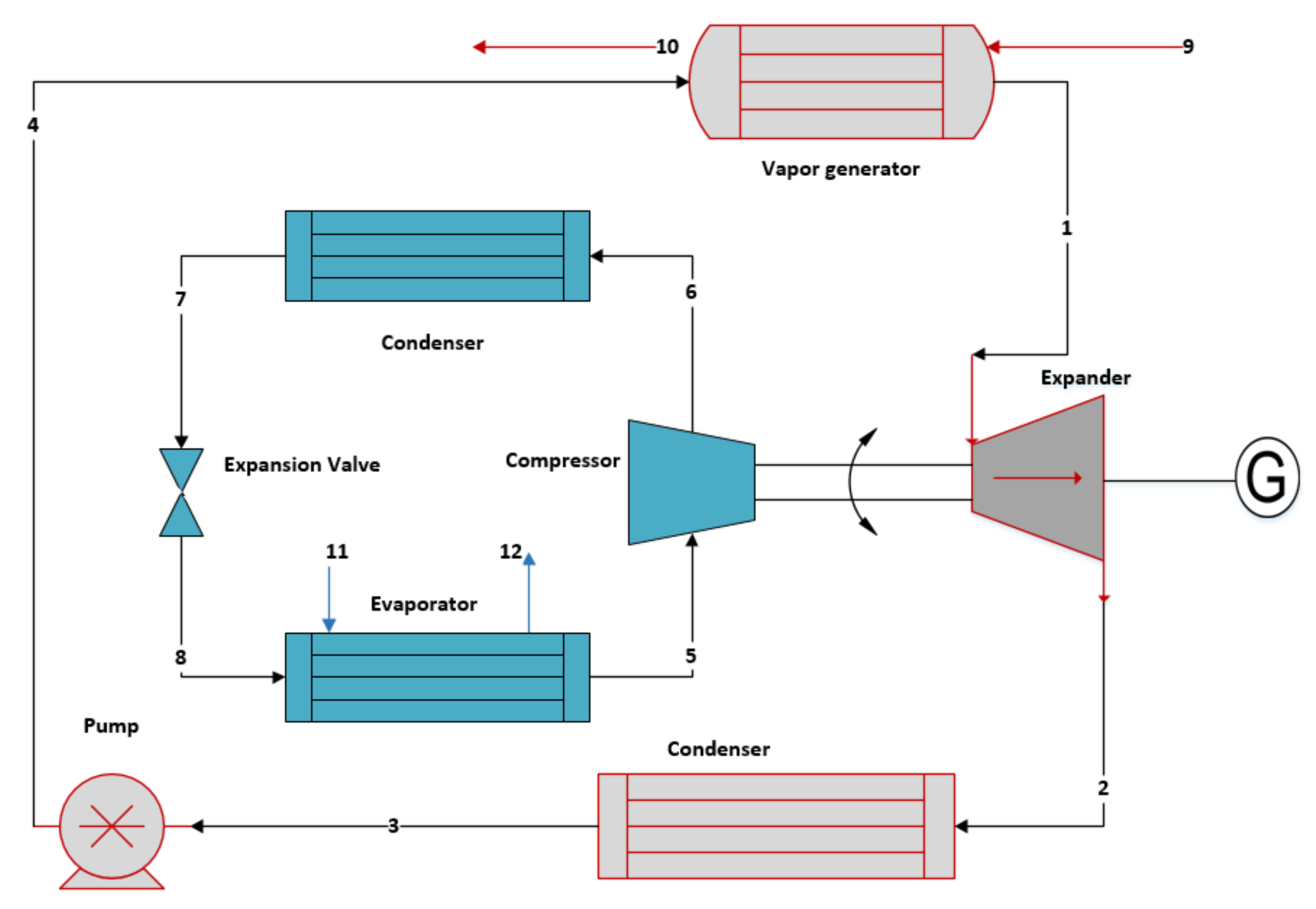
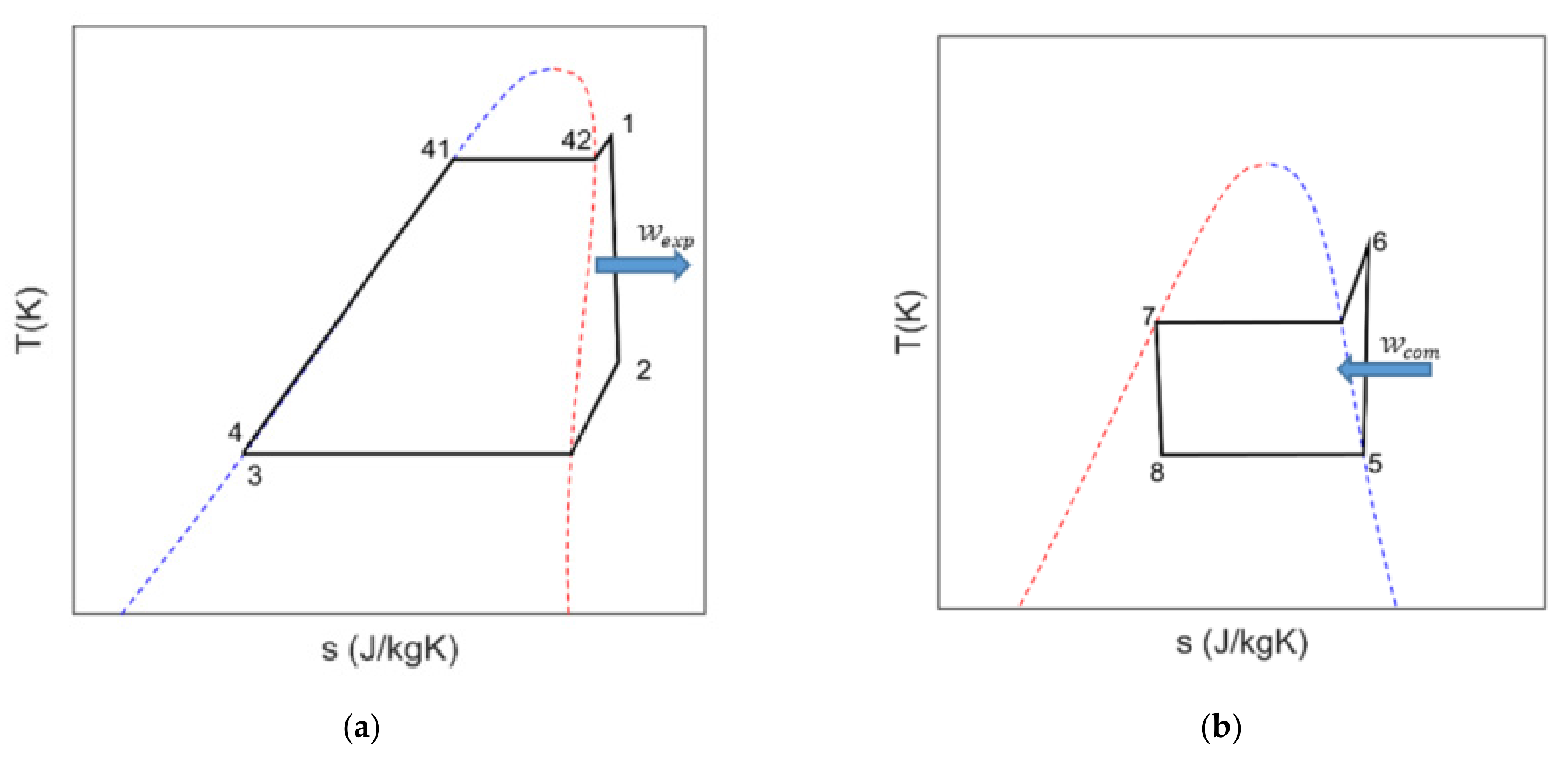
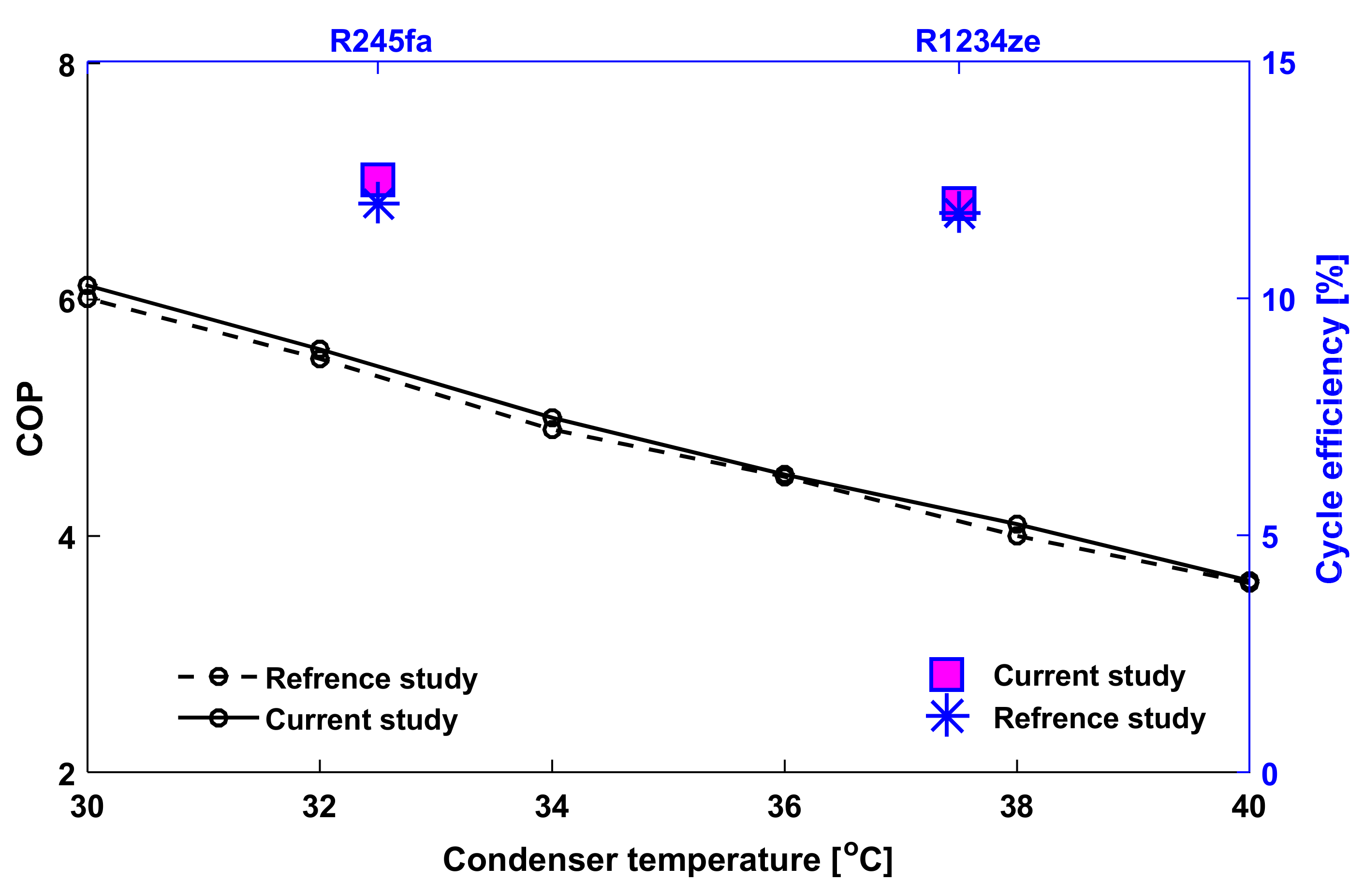
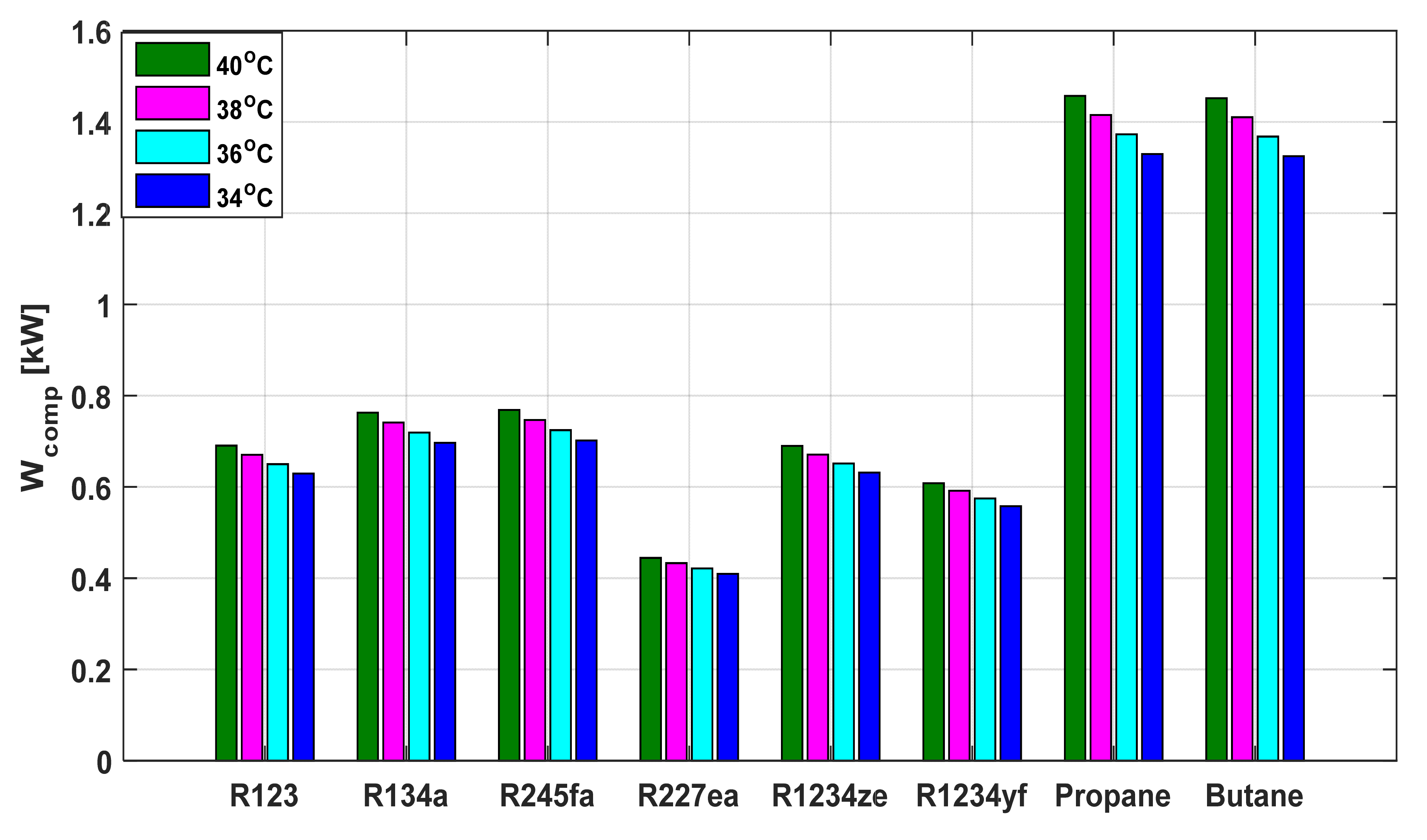
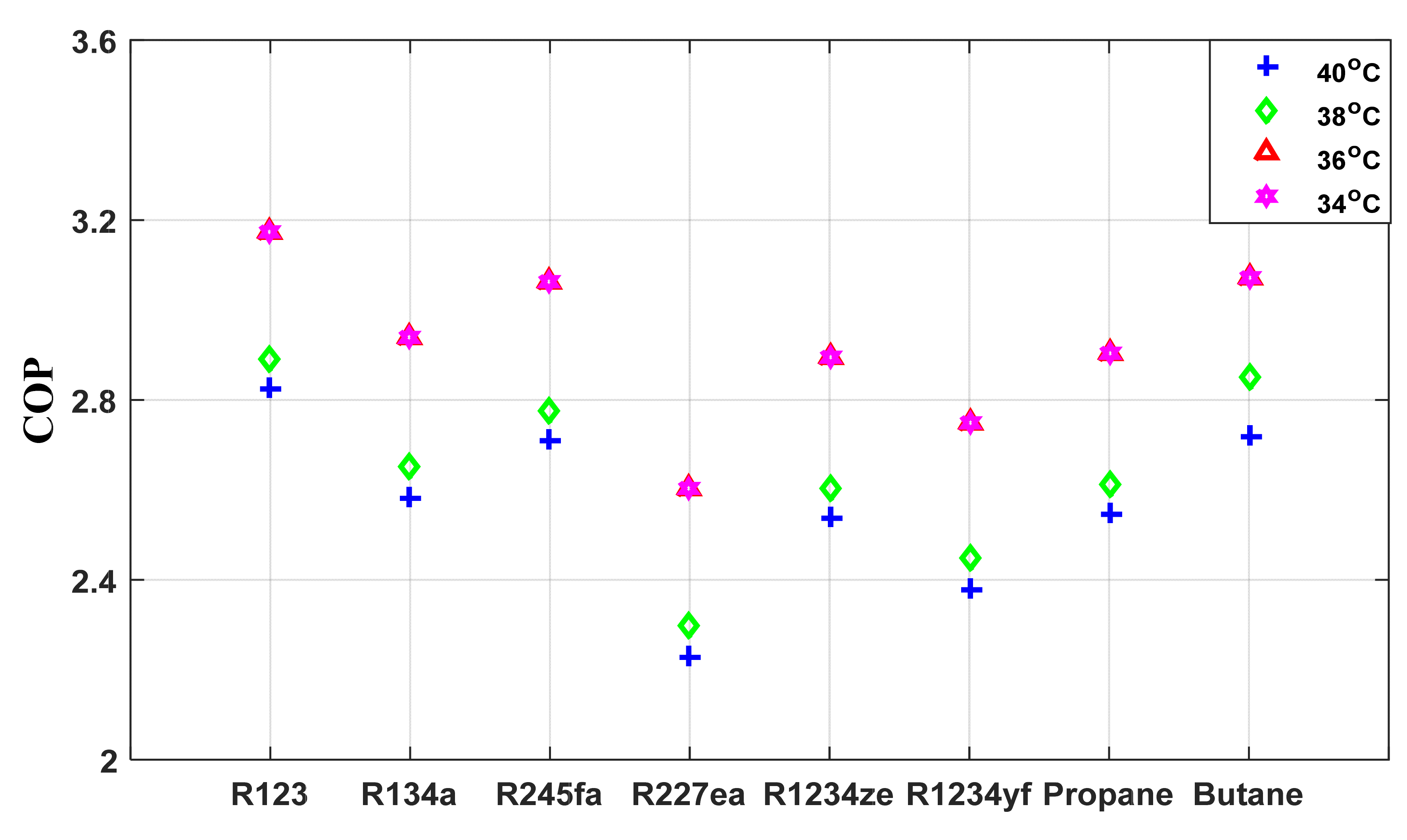
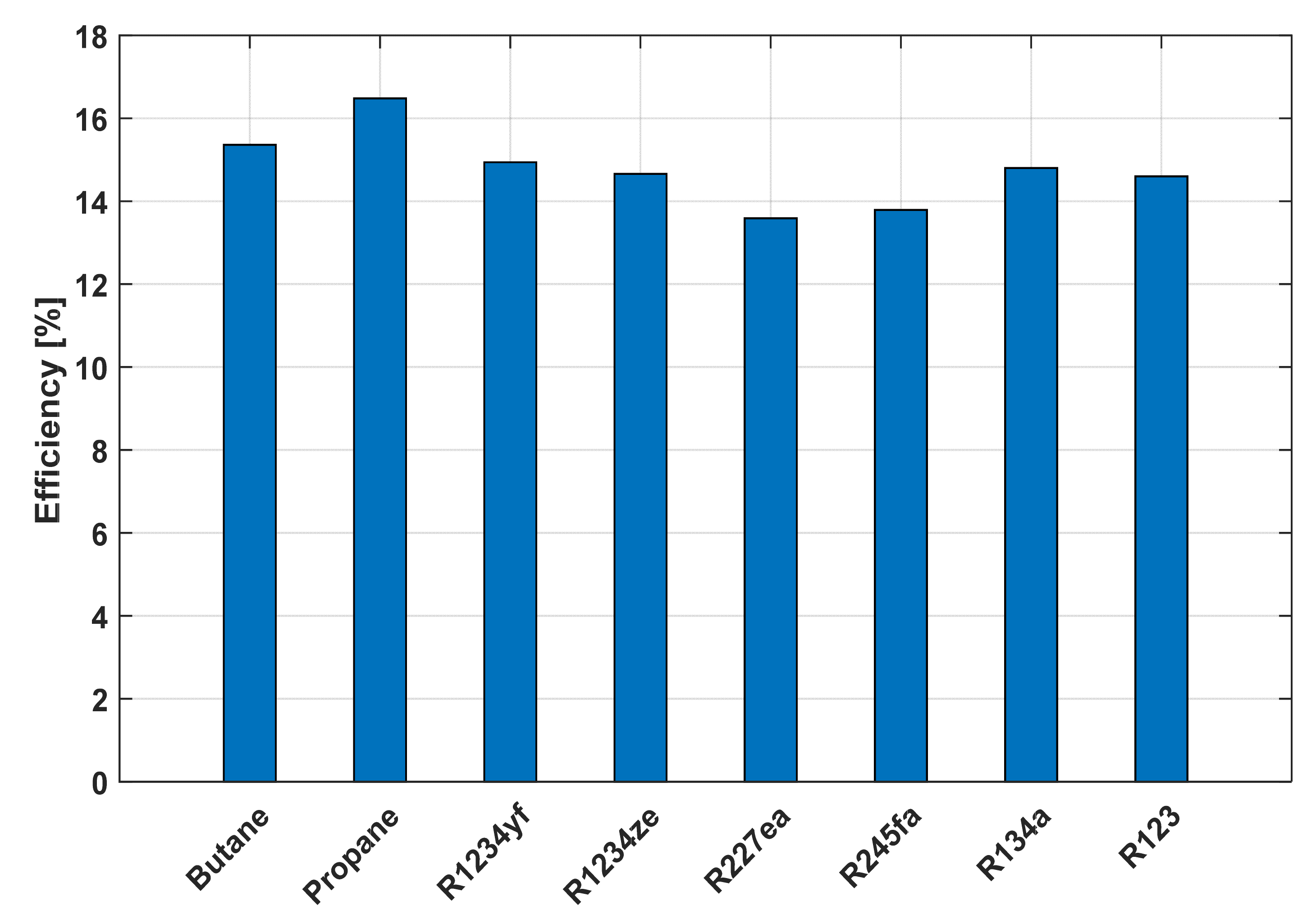
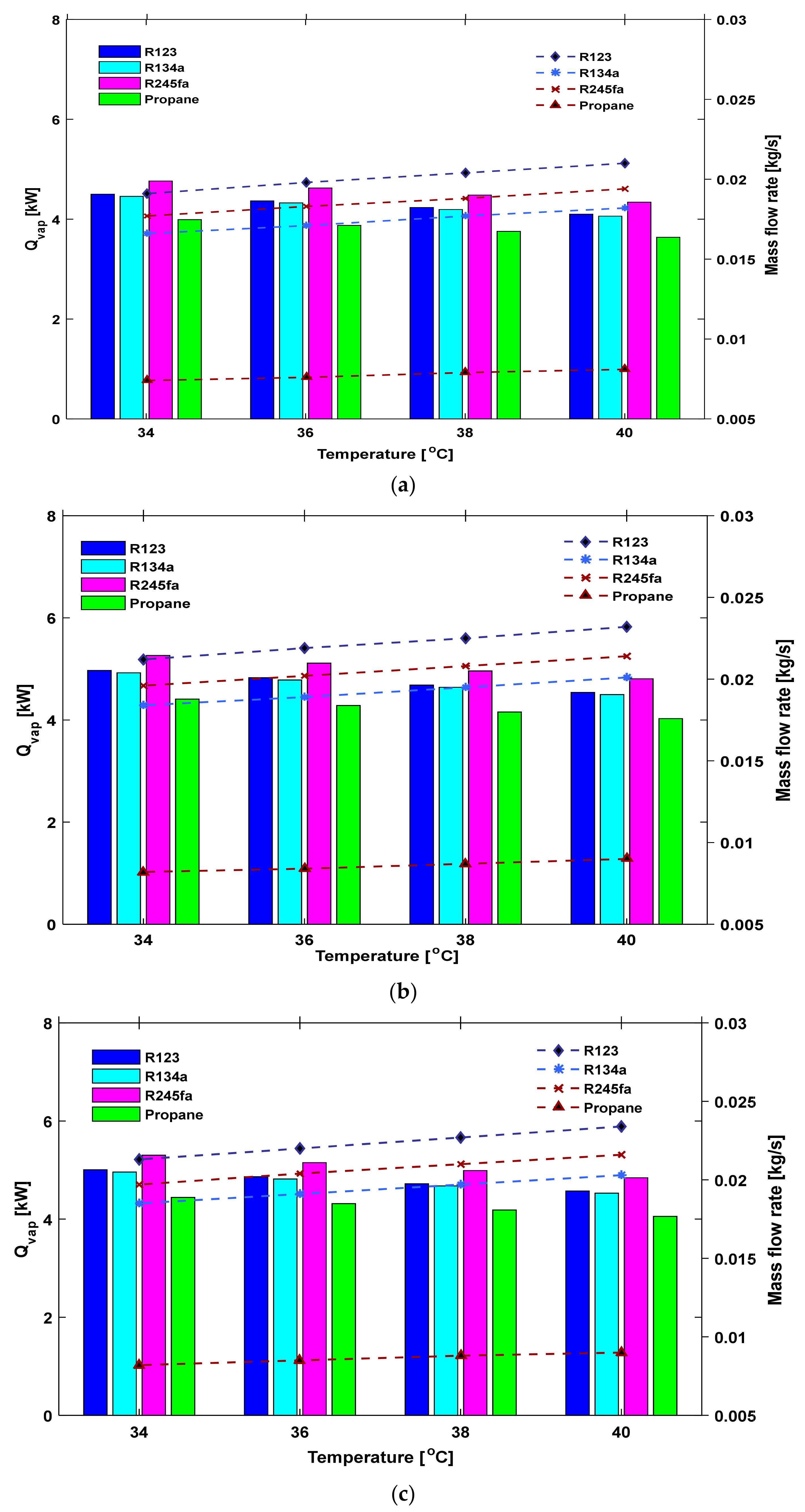
| Working Fluid | Molar Mass (kg/kmol) | Critical Temperature (°C) | Critical Pressure (MPa) | ODP | GWP |
|---|---|---|---|---|---|
| R123 | 152.93 | 183.68 | 3.66 | 0.012 | 76 |
| R134a | 102.03 | 101.06 | 4.06 | 0 | 1430 |
| R245fa | 134.05 | 154.01 | 3.651 | 0 | 820 |
| R227ea | 170.03 | 101.75 | 29.25 | 0 | 322 |
| R1234ze | 114.04 | 109.36 | 3.64 | 0 | 6 |
| R1234yf | 114.04 | 94.70 | 3.38 | 0 | 4 |
| Propane | 44.096 | 96.74 | 42.512 | 0 | 3.3 |
| Butane | 58.13 | 151.98 | 3.80 | 0 | 20 |
| Working Fluid | Condenser Temperature | ||||||||
|---|---|---|---|---|---|---|---|---|---|
| VCC | ORC | 40 °C | 38 °C | 36 °C | 34 °C | ||||
| R123 | R123 | 0.021 | 4.499 | 0.0204 | 4.367 | 0.0198 | 4.234 | 0.0191 | 4.099 |
| R134a | 0.0182 | 4.457 | 0.0177 | 4.327 | 0.0171 | 4.195 | 0.0166 | 4.061 | |
| R245fa | 0.0194 | 4.765 | 0.0188 | 4.625 | 0.0183 | 4.484 | 0.0177 | 4.341 | |
| R227ea | 0.0278 | 4.772 | 0.027 | 4.632 | 0.0262 | 4.491 | 0.0254 | 4.348 | |
| R1234ze | 0.0192 | 4.474 | 0.0189 | 4.343 | 0.018 | 4.210 | 0.0175 | 4.076 | |
| R1234yf | 0.0201 | 4.372 | 0.0195 | 4.244 | 0.0189 | 4.115 | 0.0183 | 3.984 | |
| Propane | 0.0081 | 3.992 | 0.0079 | 3.875 | 0.0076 | 3.757 | 0.0074 | 3.637 | |
| Butane | 0.0086 | 4.278 | 0.0083 | 4.153 | 0.0081 | 4.026 | 0.0078 | 3.898 | |
| R134a | R123 | 0.0232 | 4.969 | 0.0225 | 4.828 | 0.0219 | 4.684 | 0.0212 | 4.539 |
| R134a | 0.0201 | 4.923 | 0.0195 | 4.783 | 0.0189 | 4.641 | 0.0184 | 4.497 | |
| R245fa | 0.0214 | 5.263 | 0.0208 | 5.113 | 0.0202 | 4.961 | 0.0196 | 4.807 | |
| R227ea | 0.0307 | 5.271 | 0.0299 | 5.121 | 0.029 | 4.969 | 0.0281 | 4.814 | |
| R1234ze | 0.0212 | 4.941 | 0.0206 | 4.801 | 0.0199 | 4.658 | 0.0193 | 4.513 | |
| R1234yf | 0.0222 | 4.830 | 0.0215 | 4.692 | 0.0209 | 4.553 | 0.0203 | 4.411 | |
| Propane | 0.009 | 4.409 | 0.0087 | 4.284 | 0.0084 | 4.156 | 0.0082 | 4.027 | |
| Butane | 0.0095 | 4.726 | 0.0092 | 4.591 | 0.0089 | 4.455 | 0.0087 | 4.316 | |
| R245fa | R123 | 0.0234 | 5.007 | 0.0227 | 4.864 | 0.022 | 4.72 | 0.0213 | 4.573 |
| R134a | 0.0203 | 4.961 | 0.0197 | 4.819 | 0.0191 | 4.676 | 0.0185 | 4.530 | |
| R245fa | 0.0216 | 5.303 | 0.021 | 5.152 | 0.0204 | 4.999 | 0.0197 | 4.843 | |
| R227ea | 0.031 | 5.311 | 0.0301 | 5.16 | 0.0292 | 5.006 | 0.0283 | 4.850 | |
| R1234ze | 0.0213 | 4.979 | 0.0207 | 4.837 | 0.0201 | 4.693 | 0.0195 | 4.547 | |
| R1234yf | 0.0223 | 4.866 | 0.0217 | 4.728 | 0.0211 | 4.587 | 0.0204 | 4.444 | |
| Propane | 0.009 | 4.443 | 0.0088 | 4.316 | 0.0085 | 4.187 | 0.0082 | 4.057 | |
| Butane | 0.0096 | 4.762 | 0.0093 | 4.626 | 0.009 | 4.488 | 0.0087 | 4.348 | |
| R227ea | R123 | 0.0135 | 2.895 | 0.0132 | 2.821 | 0.0128 | 2.744 | 0.0124 | 2.667 |
| R134a | 0.0117 | 2.868 | 0.0114 | 2.794 | 0.0111 | 2.719 | 0.0108 | 2.642 | |
| R245fa | 0.0125 | 3.066 | 0.0122 | 2.987 | 0.0118 | 2.907 | 0.0115 | 2.827 | |
| R227ea | 0.0179 | 3.071 | 0.0174 | 2.992 | 0.017 | 2.911 | 0.0165 | 2.828 | |
| R1234ze | 0.0123 | 2.879 | 0.012 | 2.805 | 0.0117 | 2.729 | 0.0114 | 2.651 | |
| R1234yf | 0.0129 | 2.814 | 0.0126 | 2.741 | 0.0122 | 2.667 | 0.0119 | 2.592 | |
| Propane | 0.0052 | 2.569 | 0.0051 | 2.503 | 0.0049 | 2.435 | 0.0048 | 2.366 | |
| Butane | 0.0055 | 2.753 | 0.0054 | 2.682 | 0.0052 | 2.610 | 0.0051 | 2.536 | |
| R1234ze | R123 | 0.021 | 4.495 | 0.0204 | 4.370 | 0.0198 | 4.243 | 0.0192 | 4.113 |
| R134a | 0.0182 | 4.454 | 0.0177 | 4.33 | 0.0172 | 4.203 | 0.0166 | 4.075 | |
| R245fa | 0.0194 | 4.761 | 0.0189 | 4.628 | 0.0183 | 4.493 | 0.0177 | 4.356 | |
| R227ea | 0.0278 | 4.768 | 0.027 | 4.635 | 0.0262 | 4.500 | 0.0254 | 4.363 | |
| R1234ze | 0.0191 | 4.470 | 0.0186 | 4.345 | 0.0181 | 4.219 | 0.0175 | 4.090 | |
| R1234yf | 0.0201 | 4.369 | 0.0195 | 4.247 | 0.0189 | 4.123 | 0.0184 | 3.998 | |
| Propane | 0.0081 | 3.988 | 0.0079 | 3.877 | 0.0076 | 3.764 | 0.0074 | 3.65 | |
| Butane | 0.0086 | 4.275 | 0.0083 | 4.156 | 0.0081 | 4.034 | 0.0079 | 3.911 | |
| R1234yf | R123 | 0.0185 | 3.962 | 0.018 | 3.854 | 0.0175 | 3.744 | 0.0169 | 3.633 |
| R134a | 0.016 | 3.925 | 0.0156 | 3.818 | 0.0151 | 3.71 | 0.0147 | 3.599 | |
| R245fa | 0.0171 | 4.196 | 0.0166 | 4.082 | 0.0162 | 3.966 | 0.0157 | 3.847 | |
| R227ea | 0.0245 | 4.202 | 0.0238 | 4.088 | 0.0232 | 3.971 | 0.0225 | 3.853 | |
| R1234ze | 0.0169 | 3.939 | 0.0164 | 3.832 | 0.0159 | 3.723 | 0.0155 | 3.612 | |
| R1234yf | 0.0177 | 3.855 | 0.0172 | 3.745 | 0.0167 | 3.639 | 0.0162 | 3.530 | |
| Propane | 0.0071 | 3.515 | 0.0069 | 3.419 | 0.0067 | 3.322 | 0.0065 | 3.223 | |
| Butane | 0.0076 | 3.767 | 0.0074 | 3.665 | 0.0071 | 3.561 | 0.0069 | 3.454 | |
| Propane | R123 | 0.0443 | 9.493 | 0.043 | 9.22 | 0.0417 | 8.943 | 0.0404 | 8.662 |
| R134a | 0.0384 | 9.405 | 0.0373 | 9.134 | 0.0362 | 8.860 | 0.035 | 8.582 | |
| R245fa | 0.041 | 10.05 | 0.0398 | 9.765 | 0.0386 | 9.472 | 0.0374 | 9.175 | |
| R227ea | 0.0587 | 10.06 | 0.057 | 9.779 | 0.0553 | 9.485 | 0.0536 | 9.188 | |
| R1234ze | 0.0404 | 9.439 | 0.0393 | 9.167 | 0.0381 | 8.892 | 0.0369 | 8.613 | |
| R1234yf | 0.0424 | 9.225 | 0.0411 | 8.960 | 0.0399 | 8.691 | 0.0387 | 8.419 | |
| Propane | 0.0171 | 8.422 | 0.0166 | 8.180 | 0.0161 | 7.931 | 0.0156 | 7.686 | |
| Butane | 0.0181 | 9.027 | 0.0176 | 8.767 | 0.0171 | 8.504 | 0.0165 | 8.237 | |
| Butane | R123 | 0.0441 | 9.460 | 0.0429 | 9.188 | 0.0416 | 8.912 | 0.0403 | 8.632 |
| R134a | 0.0383 | 9.372 | 0.0372 | 9.103 | 0.036 | 8.829 | 0.0349 | 8.559 | |
| R245fa | 0.0408 | 10.01 | 0.0396 | 9.731 | 0.0385 | 9.439 | 0.0372 | 9.143 | |
| R227ea | 0.0585 | 10.03 | 0.0568 | 9.745 | 0.0551 | 9.453 | 0.0534 | 9.156 | |
| R1234ze | 0.0403 | 9.406 | 0.0391 | 9.136 | 0.038 | 8.861 | 0.0368 | 8.583 | |
| R1234yf | 0.0422 | 9.194 | 0.041 | 8.929 | 0.0398 | 8.661 | 0.0385 | 8.389 | |
| Propane | 0.017 | 8.393 | 0.0166 | 8.152 | 0.0161 | 7.907 | 0.0156 | 7.659 | |
| Butane | 0.0181 | 8.996 | 0.0175 | 8.737 | 0.017 | 8.475 | 0.0165 | 8.209 | |
Publisher’s Note: MDPI stays neutral with regard to jurisdictional claims in published maps and institutional affiliations. |
© 2021 by the authors. Licensee MDPI, Basel, Switzerland. This article is an open access article distributed under the terms and conditions of the Creative Commons Attribution (CC BY) license (http://creativecommons.org/licenses/by/4.0/).
Share and Cite
Khatoon, S.; Almefreji, N.M.A.; Kim, M.-H. Thermodynamic Study of a Combined Power and Refrigeration System for Low-Grade Heat Energy Source. Energies 2021, 14, 410. https://doi.org/10.3390/en14020410
Khatoon S, Almefreji NMA, Kim M-H. Thermodynamic Study of a Combined Power and Refrigeration System for Low-Grade Heat Energy Source. Energies. 2021; 14(2):410. https://doi.org/10.3390/en14020410
Chicago/Turabian StyleKhatoon, Saboora, Nasser Mohammed A. Almefreji, and Man-Hoe Kim. 2021. "Thermodynamic Study of a Combined Power and Refrigeration System for Low-Grade Heat Energy Source" Energies 14, no. 2: 410. https://doi.org/10.3390/en14020410
APA StyleKhatoon, S., Almefreji, N. M. A., & Kim, M.-H. (2021). Thermodynamic Study of a Combined Power and Refrigeration System for Low-Grade Heat Energy Source. Energies, 14(2), 410. https://doi.org/10.3390/en14020410







